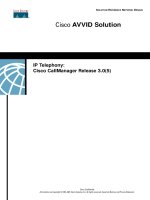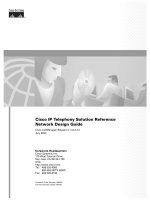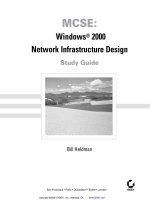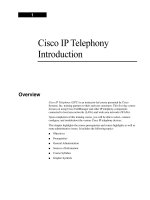Tài liệu Cisco IP Telephony Network Design Guide - Cisco CallManager Release 3.0(5) doc
Bạn đang xem bản rút gọn của tài liệu. Xem và tải ngay bản đầy đủ của tài liệu tại đây (5 MB, 262 trang )
170 West Tasman Drive
San Jose, CA 95134-1706
USA
Cisco Systems, Inc.
Corporate Headquarters
Tel:
800 553-NETS (6387)
408 526-4000
Fax: 408 526-4100
Cisco IP Telephony
Network Design Guide
Cisco CallManager Release 3.0(5)
Customer Order Number: DOC-7811103=
Text Part Number: 78-11103-03
THE SPECIFICATIONS AND INFORMATION REGARDING THE PRODUCTS IN THIS MANUAL ARE SUBJECT TO CHANGE WITHOUT
NOTICE. ALL STATEMENTS, INFORMATION, AND RECOMMENDATIONS IN THIS MANUAL ARE BELIEVED TO BE ACCURATE BUT
ARE PRESENTED WITHOUT WARRANTY OF ANY KIND, EXPRESS OR IMPLIED. USERS MUST TAKE FULL RESPONSIBILITY FOR
THEIR APPLICATION OF ANY PRODUCTS.
THE SOFTWARE LICENSE AND LIMITED WARRANTY FOR THE ACCOMPANYING PRODUCT ARE SET FORTH IN THE INFORMATION
PACKET THAT SHIPPED WITH THE PRODUCT AND ARE INCORPORATED HEREIN BY THIS REFERENCE. IF YOU ARE UNABLE TO
LOCATE THE SOFTWARE LICENSE OR LIMITED WARRANTY, CONTACT YOUR CISCO REPRESENTATIVE FOR A COPY.
The Cisco implementation of TCP header compression is an adaptation of a program developed by the University of California, Berkeley (UCB) as
part of UCB’s public domain version of the UNIX operating system. All rights reserved. Copyright © 1981, Regents of the University of California.
NOTWITHSTANDING ANY OTHER WARRANTY HEREIN, ALL DOCUMENT FILES AND SOFTWARE OF THESE SUPPLIERS ARE
PROVIDED “AS IS” WITH ALL FAULTS. CISCO AND THE ABOVE-NAMED SUPPLIERS DISCLAIM ALL WARRANTIES, EXPRESSED
OR IMPLIED, INCLUDING, WITHOUT LIMITATION, THOSE OF MERCHANTABILITY, FITNESS FOR A PARTICULAR PURPOSE AND
NONINFRINGEMENT OR ARISING FROM A COURSE OF DEALING, USAGE, OR TRADE PRACTICE.
IN NO EVENT SHALL CISCO OR ITS SUPPLIERS BE LIABLE FOR ANY INDIRECT, SPECIAL, CONSEQUENTIAL, OR INCIDENTAL
DAMAGES, INCLUDING, WITHOUT LIMITATION, LOST PROFITS OR LOSS OR DAMAGE TO DATA ARISING OUT OF THE USE OR
INABILITY TO USE THIS MANUAL, EVEN IF CISCO OR ITS SUPPLIERS HAVE BEEN ADVISED OF THE POSSIBILITY OF SUCH
DAMAGES.
AtmDirector, Browse with Me, CCDA, CCDE, CCDP, CCIE, CCNA, CCNP, CCSI, CD-PAC, CiscoLink, the Cisco NetWorks logo, the Cisco Powered
Network logo, Cisco Systems Networking Academy, the Cisco Systems Networking Academy logo, Fast Step, Follow Me Browsing,
FormShare,FrameShare, GigaStack, IGX, Internet Quotient, IP/VC, iQ Breakthrough, iQ Expertise, iQ FastTrack, the iQ Logo, iQ Net Readiness
Scorecard, MGX, the Networkers logo, Packet, PIX, RateMUX, ScriptShare, SlideCast, SMARTnet, TransPath, Voice LAN, Wavelength Router,
WebViewer are trademarks of Cisco Systems, Inc.; Changing the Way We Work, Live, Play, and Learn, Empowering the Internet Generation, are
service marks of Cisco Systems, Inc.; and Aironet, ASIST, BPX, Catalyst, Cisco, the Cisco Certified Internetwork Expert Logo, Cisco IOS, the Cisco
IOS logo, Cisco Systems, Cisco Systems Capital, the Cisco Systems logo, Enterprise/Solver, EtherChannel, EtherSwitch, FastHub, IOS, IP/TV,
LightStream, Post-Routing, Pre-Routing, Registrar, StrataView Plus, Stratm, SwitchProbe, TeleRouter, and VCO are registered trademarks of Cisco
Systems, Inc. or its affiliates in the U.S. and certain other countries.
All other brands, names, or trademarks mentioned in this document or Web site are the property of their respective owners. The use of the word
partner does not imply a partnership relationship between Cisco and any other company. (0011R)
Cisco IP Telephony Network Design Guide
Copyright © 2000, 2001, Cisco Systems, Inc.
All rights reserved.
iii
Cisco IP Telephony Network Design Guide
78-11103-03
CONTENTS
Preface xi
Purpose
xi
Audience
xii
Organization
xii
Revision History
xiv
Conventions
xv
Additional Information
xvii
Obtaining Documentation
xviii
World Wide Web
xviii
Documentation CD-ROM
xviii
Ordering Documentation
xviii
Documentation Feedback
xix
Obtaining Technical Assistance
xix
Cisco.com
xix
Technical Assistance Center
xx
Contacting TAC by Using the Cisco TAC Website
xx
Contacting TAC by Telephone
xxi
CHAPTER
1
Introduction
1-1
General Design Models
1-1
Single-Site Model
1-3
Multiple Sites with Independent Call Processing
1-5
Contents
iv
Cisco IP Telephony Network Design Guide
78-11103-03
Multisite IP WAN with Distributed Call Processing
1-7
Multisite IP WAN with Centralized Call Processing
1-10
CHAPTER
2
Campus Infrastructure Considerations
2-1
Overview
2-2
Power Protection Strategies
2-4
Network Infrastructure
2-5
High Availability
2-7
Physical Connectivity Options
2-9
Power to IP Phones
2-10
Inline Power
2-10
Establishing Power to the IP Phone
2-12
Inline Power Configuration
2-13
Other Inline Power Considerations
2-15
External Patch Panel Power
2-17
Wall Power
2-20
Summary of Recommendations
2-20
IP Addressing and Management
2-21
CDP Enhancements
2-22
VVID Field
2-22
Trigger Field
2-22
Power Requirement Field
2-23
Auxiliary VLANs and Data VLANs
2-23
Voice VLAN Configuration
2-24
Connecting to the Network
2-25
Sample Addressing Plan and Recommendations
2-26
v
Cisco IP Telephony Network Design Guide
78-11103-03
Contents
Quality of Service
2-28
Traffic Classification Types
2-28
Trust Boundaries
2-29
Traffic Classification at Layer 2
2-30
Traffic Classification at Layer 3
2-34
Layer 3 Traffic Classification on the Cisco Catalyst 6000
2-34
Summary of Capabilities and Recommendations
2-36
CHAPTER
3
Cisco CallManager Clusters
3-1
Cluster Operation and Scalability Guidelines
3-1
Device Weights
3-3
Intracluster Communication
3-5
Cisco CallManager Redundancy
3-6
Redundancy Group Configurations
3-6
Device Pool Configuration
3-9
Campus Clustering Guidelines
3-12
Intercluster Communication
3-14
Cluster Provisioning for the Campus
3-14
Clusters for Multisite WAN with Distributed Call Processing
3-15
Clusters for Multisite WAN with Centralized Call Processing
3-18
Intracluster and Intercluster Feature Transparency
3-21
Contents
vi
Cisco IP Telephony Network Design Guide
78-11103-03
CHAPTER
4
Gateway Selection
4-1
Supported Protocols
4-2
DTMF Relay
4-3
Skinny Gateways
4-4
Cisco IOS H.323 Gateways
4-4
MGCP Gateway
4-4
Cisco CallManager Redundancy
4-5
Skinny Gateways
4-5
IOS H.323 Gateways
4-5
MGCP Gateway
4-6
Supplementary Services
4-7
Skinny Gateways
4-7
IOS H.323 Gateways
4-8
MGCP Gateway
4-9
Site-Specific Gateway Requirements
4-9
CHAPTER
5
Dial Plan Architecture and Configuration
5-1
Cisco CallManager Dial Plan Architecture
5-1
Route Pattern
5-6
Route List
5-7
Route Group
5-7
Devices
5-8
Digit Translation Tables
5-9
Special Dial String Considerations
5-10
On-Net Route Pattern
5-11
Outbound Calls Through the PSTN
5-12
vii
Cisco IP Telephony Network Design Guide
78-11103-03
Contents
Configuring Dial Plan Groups and Calling Restrictions
5-14
Partitions
5-15
Calling Search Space
5-15
Dial Plan Guidelines and Configuration
5-18
Campus and Individual Site Dial Plans
5-19
Multi-Site WAN Dial Plans
5-21
The Role of a Gatekeeper
5-21
CHAPTER
6
Multisite WAN with Distributed Call Processing
6-1
Distributed Call Processing Model
6-1
Call Admission Control
6-3
Operational Model
6-8
Gatekeeper Configuration
6-9
Cisco CallManager Configuration
6-10
Interaction Between Cisco CallManager and Gatekeeper
6-11
Considerations for Using a Gatekeeper
6-15
Dial Plan Considerations
6-15
Using Cisco CallManager to Route Calls
6-17
Using the Gatekeeper to Route Calls
6-19
Cisco CallManager Configuration
6-22
Gatekeeper Configuration
6-27
Gatekeeper Selection and Redundancy
6-28
Configuring Dialing Restrictions
6-28
Bandwidth Consumption of Dialed Numbers
6-28
Cisco CallManager Cluster Considerations
6-30
DSP Resource Provisioning for Transcoding and Conferencing
6-30
Voice Messaging Considerations
6-32
Contents
viii
Cisco IP Telephony Network Design Guide
78-11103-03
CHAPTER
7
Multisite WAN with Centralized Call Processing
7-1
Centralized Call Processing Model
7-1
Call Admission Control
7-3
Caveats for Locations-Based Call Admission Control
7-4
Dial Plan Considerations
7-5
Interlocation Calls
7-5
Intercluster Calls
7-6
Local PSTN Calls
7-6
Design Example
7-6
Cisco CallManager Cluster Considerations
7-8
DSP Resource Provisioning for Transcoding and Conferencing
7-10
Voice Messaging Considerations
7-12
CHAPTER
8
Quality of Service
8-1
Campus QoS Model
8-1
Traffic Classification
8-2
Interface Queuing
8-2
WAN QoS Model
8-4
WAN Provisioning
8-4
WAN QoS Tools
8-5
Traffic Prioritization
8-5
Link Efficiency Techniques
8-7
Traffic Shaping
8-9
Best Practices
8-10
Call Admission Control
8-11
ix
Cisco IP Telephony Network Design Guide
78-11103-03
Contents
CHAPTER
9
Catalyst DSP Provisioning
9-1
Understanding the Catalyst DSP Resources
9-2
Catalyst Conferencing Services
9-4
Conferencing Design Details
9-4
Conferencing Caveats
9-6
Catalyst MTP Transcoding Services
9-7
MTP Transcoding Design Details
9-7
IP-to-IP Packet Transcoding and Voice Compression
9-7
Voice Compression, IP-to-IP Packet Transcoding, and Conferencing
9-9
IP-to-IP Packet Transcoding Across Intercluster Trunks
9-10
MTP Transcoding Caveats
9-12
Catalyst 4000 Voice Services
9-13
Catalyst 6000 Voice Services
9-15
CHAPTER
10
Migrating to an IP Telephony Network
10-1
Network Models
10-1
PBX and Voice Messaging Interfaces and Protocols
10-2
Simple IP Network Migration Sequence
10-3
Reference Models for Migration Configurations
10-6
Detailed Discussion of Model A
10-7
Detailed Discussion of Model B
10-12
Detailed Discussion of Model C
10-15
Detailed Discussion of Model D
10-18
Cisco Digital PBX Adapter (DPA)
10-20
Understanding How the DPA 7630 Works
10-21
Why is the DPA 7630 Needed?
10-21
Contents
x
Cisco IP Telephony Network Design Guide
78-11103-03
Can I Just Use SMDI?
10-21
What If I Cannot Use SMDI?
10-22
Choosing an Integration Mode
10-22
Using the Simple Integration Mode
10-23
Using the Hybrid Integration Mode
10-24
Using the Multiple Integration Mode
10-25
CHAPTER
11
Network Management
11-1
Remote Serviceability for Cisco CallManager
11-1
SNMP Instrumentation on the Cisco CallManager Server
11-2
System Logging Components
11-3
Syslog Collector
11-4
Syslog Administrative Interface
11-6
CiscoWorks2000 Voice Management Features
11-8
Campus Manager
11-11
User Tracking
11-12
Trace Path Analysis
11-13
Resource Manager Essentials
11-15
Inventory Control and Reporting
11-15
System Logging Management
11-16
Syslog Message Filtering
11-18
Alarms
11-19
GLOSSARY
INDEX
xi
Cisco IP Telephony Network Design Guide
78-11103-03
Preface
This preface describes the purpose, intended audience, organization, and conventions
for the Cisco IP Telephony Network Design Guide.
Purpose
This document serves as an implementation guide for Cisco AVVID (Architecture
for Voice, Video and Integrated Data) networks based on Cisco CallManager
Release 3.0(5). With such a high level of industry interest regarding IP telephony,
customers are aggressively pursuing Cisco solutions for both large and small
networks. Solutions based on Cisco CallManager Release 3.0(5) allow Cisco to
deliver large-scale IP telephony systems with many capabilities.
However, it is important to ensure that these systems fit successfully within a set
of boundaries. This document serves as a guide to all aspects of designing
Cisco AVVID networks, and includes working configurations. The many new
hardware and software capabilities in Cisco CallManager Release 3.0(5) are
covered in detail in the various solutions and deployment models. Important
components such as minimum Cisco IOS release requirements and recommended
platforms are noted for each model.
This document will be updated as the Cisco AVVID solution set grows with
subsequent releases of Cisco CallManager.
Preface
Audience
xii
Cisco IP Telephony Network Design Guide
78-11103-03
Audience
This guide is intended for systems engineers and others responsible for designing
Cisco AVVID networks based on Cisco CallManager Release 3.0(5).
Caution
The design guidelines in this document are based on the best
currently available knowledge about the functionality and operation
of the Cisco AVVID components. The information in this document
is subject to change without notice.
Organization
Following are the chapters of this guide and the subjects they address:
Chapter Title Description
Chapter 1 Introduction Gives a high-level overview of each Cisco AVVID
deployment model and defines the boundaries for
these designs.
Chapter 2 Campus Infrastructure
Considerations
Discusses issues to consider when preparing a LAN
infrastructure for a Cisco AVVID solution.
Chapter 3 Cisco CallManager Clusters Discusses the concept, provisioning, and
configuration of Cisco CallManager clusters.
Chapter 4 Gateway Selection Discusses issues concerning the selection of gateways
for connecting an IP telephony network to the PSTN
or to legacy PBX and key systems.
Chapter 5 Dial Plan Architecture and
Configuration
Discusses the architecture and operation of the
Cisco CallManager dial plan and provides design
recommendations for campus environments.
Chapter 6 Multisite WAN with Distributed
Call Processing
Provides design guidelines for multi-site WAN
systems using Cisco CallManager Release 3.0(5) for
distributed call processing.
xiii
Cisco IP Telephony Network Design Guide
78-11103-03
Preface
Organization
Chapter 7 Multisite WAN with Centralized
Call Processing
Provides design guidelines for multi-site WAN
systems using Cisco CallManager Release 3.0(5) for
centralized call processing.
Chapter 8 Quality of Service Addresses the QoS requirements for Cisco AVVID
implementations over the enterprise WAN.
Chapter 9 Catalyst DSP Provisioning Describes the Catalyst digital signal processor (DSP)
resources and discusses how to provision these
resources.
Chapter 10 Migrating to an IP Telephony
Network
Explains how an enterprise can migrate from a
conventional PBX and its adjunct systems
(principally voice messaging) to a Cisco AVVID
network.
Chapter 11 Network Management Introduces features of CiscoWorks2000 and Remote
Serviceability for Cisco CallManager that provide
network management capabilities for Cisco AVVID
networks.
Chapter Title Description
Preface
Revision History
xiv
Cisco IP Telephony Network Design Guide
78-11103-03
Revision History
The following revisions have been made to this document:
Revision Date Major Changes Since Previous Edition
12/08/00
•
Added Chapter 11 on network management.
•
Revised gatekeeper information in Chapter 6.
11/22/00
•
Revised document for Cisco CallManager Release 3.0(5).
•
Updated details of campus infrastructure design in
Chapter 2.
•
Revised bandwidth requirements for inter-cluster calls in
Chapter 3.
•
Updated gateway information in Chapter 4.
•
Added gatekeeper information to Chapter 5.
•
Updated details of call admission control and gatekeepers
in Chapter 6.
•
Revised major portions of the Quality of Service (QoS)
information in Chapter 8.
•
Updated details of Catalyst DSP provisioning in
Chapter 9.
•
Removed the chapter on Cisco uOne from this book. This
information will be covered in a separate document.
•
Updated migration information in Chapter 10.
06/30/00
•
Reformatted document to allow for online display.
•
Updated details of cluster provisioning in Chapter 3.
•
Updated details of Catalyst DSP provisioning in
Chapter 9.
xv
Cisco IP Telephony Network Design Guide
78-11103-03
Preface
Conventions
Conventions
This document uses the following conventions:
Convention Description
boldface font Commands and keywords are in boldface.
italic font Arguments for which you supply values are in italics.
[ ] Elements in square brackets are optional.
{ x | y | z } Alternative keywords are grouped in braces and separated
by vertical bars.
[ x | y | z ] Optional alternative keywords are grouped in brackets
and separated by vertical bars.
string A nonquoted set of characters. Do not use quotation
marks around the string or the string will include the
quotation marks.
screen
font Terminal sessions and information the system displays
are in
screen
font.
boldface screen
font
Information you must enter is in
boldface screen
font.
italic screen font Arguments for which you supply values are in italic
screen font.
This pointer highlights an important line of text in an
example.
^ The symbol ^ represents the key labeled Control—for
example, the key combination ^D in a screen display
means hold down the Control key while you press the
Dkey.
< > Nonprinting characters, such as passwords, are in angle
brackets.
Preface
Conventions
xvi
Cisco IP Telephony Network Design Guide
78-11103-03
Notes use the following conventions:
Note
Means reader take note. Notes contain helpful suggestions or
references to material not covered in the publication.
Timesavers use the following conventions:
Timesaver
Means the described action saves time. You can save time by
performing the action described in the paragraph.
Tips use the following conventions:
Tips
Means
the information contains useful tips.
Cautions use the following conventions:
Caution
Means reader be careful. In this situation, you might do something
that could result in equipment damage or loss of data.
Warnings use the following conventions:
Warning
This warning symbol means danger. You are in a situation that
could cause bodily injury. Before you work on any equipment, you
must be aware of the hazards involved with electrical circuitry
and familiar with standard practices for preventing accidents.
xvii
Cisco IP Telephony Network Design Guide
78-11103-03
Preface
Additional Information
Additional Information
This section contains references to documents that provide additional information
on subjects covered in this guide.
•
High availability design:
–
/>hd_wp.htm
–
•
Power protection:
–
/>•
Simple Mail Transfer Protocol (SMTP):
–
/>0ug/ugsmtp.htm
•
Internet Message Access Protocol (IMAP):
–
/>•
Lightweight Directory Access Protocol Version 3 (LDAPv3):
–
/>•
Glossary of terms and acronyms:
–
/>–
/>
Preface
Obtaining Documentation
xviii
Cisco IP Telephony Network Design Guide
78-11103-03
Obtaining Documentation
The following sections provide sources for obtaining documentation from Cisco
Systems.
World Wide Web
You can access the most current Cisco documentation on the World Wide Web at
the following sites:
•
•
•
Documentation CD-ROM
Cisco documentation and additional literature are available in a CD-ROM
package, which ships with your product. The Documentation CD-ROM is
updated monthly and may be more current than printed documentation. The
CD-ROM package is available as a single unit or as an annual subscription.
Ordering Documentation
Cisco documentation is available in the following ways:
•
Registered Cisco Direct Customers can order Cisco Product documentation
from the Networking Products MarketPlace:
/>•
Registered Cisco.com users can order the Documentation CD-ROM through
the online Subscription Store:
/>•
Nonregistered Cisco.com users can order documentation through a local
account representative by calling Cisco corporate headquarters (California,
USA) at 408 526-7208 or, in North America, by calling 800
553-NETS(6387).
xix
Cisco IP Telephony Network Design Guide
78-11103-03
Preface
Obtaining Technical Assistance
Documentation Feedback
If you are reading Cisco product documentation on the World Wide Web, you can
submit technical comments electronically. Click Feedback in the toolbar and
select Documentation. After you complete the form, click Submit to send it to
Cisco.
You can e-mail your comments to
To submit your comments by mail, for your convenience many documents contain
a response card behind the front cover. Otherwise, you can mail your comments
to the following address:
Cisco Systems, Inc.
Document Resource Connection
170 West Tasman Drive
San Jose, CA 95134-9883
We appreciate your comments.
Obtaining Technical Assistance
Cisco provides Cisco.com as a starting point for all technical assistance.
Customers and partners can obtain documentation, troubleshooting tips, and
sample configurations from online tools. For Cisco.com registered users,
additional troubleshooting tools are available from the TAC website.
Cisco.com
Cisco.com is the foundation of a suite of interactive, networked services that
provides immediate, open access to Cisco information and resources at anytime,
from anywhere in the world. This highly integrated Internet application is a
powerful, easy-to-use tool for doing business with Cisco.
Cisco.com provides a broad range of features and services to help customers and
partners streamline business processes and improve productivity. Through
Cisco.com, you can find information about Cisco and our networking solutions,
services, and programs. In addition, you can resolve technical issues with online
Preface
Obtaining Technical Assistance
xx
Cisco IP Telephony Network Design Guide
78-11103-03
technical support, download and test software packages, and order Cisco learning
materials and merchandise. Valuable online skill assessment, training, and
certification programs are also available.
Customers and partners can self-register on Cisco.com to obtain additional
personalized information and services. Registered users can order products, check
on the status of an order, access technical support, and view benefits specific to
their relationships with Cisco.
To access Cisco.com, go to the following website:
Technical Assistance Center
The Cisco TAC website is available to all customers who need technical
assistance with a Cisco product or technology that is under warranty or covered
by a maintenance contract.
Contacting TAC by Using the Cisco TAC Website
If you have a priority level 3 (P3) or priority level 4 (P4) problem, contact TAC
by going to the TAC website:
/>P3 and P4 level problems are defined as follows:
•
P3—Your network performance is degraded. Network functionality is
noticeably impaired, but most business operations continue.
•
P4—You need information or assistance on Cisco product capabilities,
product installation, or basic product configuration.
In each of the above cases, use the Cisco TAC website to quickly find answers to
your questions.
To register for Cisco.com, go to the following website:
/>
xxi
Cisco IP Telephony Network Design Guide
78-11103-03
Preface
Obtaining Technical Assistance
If you cannot resolve your technical issue by using the TAC online resources,
Cisco.com registered users can open a case online by using the TAC Case Open
tool at the following website:
/>Contacting TAC by Telephone
If you have a priority level 1(P1) or priority level 2 (P2) problem, contact TAC by
telephone and immediately open a case. To obtain a directory of toll-free numbers
for your country, go to the following website:
/>P1 and P2 level problems are defined as follows:
•
P1—Your production network is down, causing a critical impact to business
operations if service is not restored quickly. No workaround is available.
•
P2—Your production network is severely degraded, affecting significant
aspects of your business operations. No workaround is available.
Preface
Obtaining Technical Assistance
xxii
Cisco IP Telephony Network Design Guide
78-11103-03
CHAPTER
1-1
Cisco IP Telephony Network Design Guide
78-11103-03
1
Introduction
This chapter presents a high-level overview of several basic models that you can
use in designing your IP telephony network. This overview provides some
guidance with respect to when and why a particular design should be selected.
Subsequent chapters delve into each network model in greater detail, beginning
with the simplest model and building to increasingly complexity models.
This chapter includes the following major sections:
•
General Design Models, page 1-1
•
Single-Site Model, page 1-3
•
Multiple Sites with Independent Call Processing, page 1-5
•
Multisite IP WAN with Distributed Call Processing, page 1-7
•
Multisite IP WAN with Centralized Call Processing, page 1-10
General Design Models
Figure 1-1 provides a composite scenario that illustrates the goals of the network
design models discussed in this guide. This scenario represents what is possible
with Cisco CallManager Release 3.0(5).
Chapter 1 Introduction
General Design Models
1-2
Cisco IP Telephony Network Design Guide
78-11103-03
Figure 1-1 Composite Model
Large campus
(Up to 10,000 users)
Telecommuter
(Without local call processing)
Branch office
(With local call processing)
Branch office
(Without local call processing)
V
V
V
IP WAN
Rest of
world
Cisco IOS
gatekeeper
PSTN
IP
IP
IP
V
IP
IP
IP
IP
IP
IP
IP
40763
1-3
Cisco IP Telephony Network Design Guide
78-11103-03
Chapter 1 Introduction
Single-Site Model
The overall goals of an IP telephony network are as follows:
•
End-to-end IP telephony
•
IP WAN as the primary voice path with the Public Switched Telephone
Network (PSTN) as the secondary voice path between sites
•
Lower total cost of ownership with greater flexibility
•
Enabling of new applications
For IP telephony networks based on Cisco CallManager Release 3.0(5), there are
four general design models that apply to the majority of implementations:
•
Single-Site Model, page 1-3
•
Multiple Sites with Independent Call Processing, page 1-5
•
Multisite IP WAN with Distributed Call Processing, page 1-7
•
Multisite IP WAN with Centralized Call Processing, page 1-10
The following sections summarize the design goals and implementation
guidelines for each of these models.
Single-Site Model
Figure 1-2 illustrates the model for an IP telephony network within a single
campus or site.









